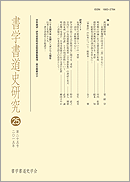Volume 2015, Issue 25
Displaying 1-11 of 11 articles from this issue
- |<
- <
- 1
- >
- >|
ARTICLES
-
2015 Volume 2015 Issue 25 Pages 1-14,180
Published: 2015
Released on J-STAGE: May 02, 2016
Download PDF (70079K) -
2015 Volume 2015 Issue 25 Pages 15-28,180-179
Published: 2015
Released on J-STAGE: May 02, 2016
Download PDF (9644K) -
2015 Volume 2015 Issue 25 Pages 29-42,179
Published: 2015
Released on J-STAGE: May 02, 2016
Download PDF (33990K) -
2015 Volume 2015 Issue 25 Pages 43-56,179-178
Published: 2015
Released on J-STAGE: May 02, 2016
Download PDF (2274K)
STUDY-NOTES
-
2015 Volume 2015 Issue 25 Pages 57-70,178
Published: 2015
Released on J-STAGE: May 02, 2016
Download PDF (51263K) -
2015 Volume 2015 Issue 25 Pages 71-84,177
Published: 2015
Released on J-STAGE: May 02, 2016
Download PDF (5985K) -
2015 Volume 2015 Issue 25 Pages 85-94,177-176
Published: 2015
Released on J-STAGE: May 02, 2016
Download PDF (2215K) -
2015 Volume 2015 Issue 25 Pages 95-107,176
Published: 2015
Released on J-STAGE: May 02, 2016
Download PDF (25342K) -
2015 Volume 2015 Issue 25 Pages 109-123,175
Published: 2015
Released on J-STAGE: May 02, 2016
Download PDF (2239K)
Reports on the Open Symposium at the 25th Meeting
-
2015 Volume 2015 Issue 25 Pages 125-162
Published: 2015
Released on J-STAGE: May 02, 2016
Download PDF (6670K)
-
2015 Volume 2015 Issue 25 Pages 163-172
Published: 2015
Released on J-STAGE: May 02, 2016
Download PDF (2005K)
- |<
- <
- 1
- >
- >|
